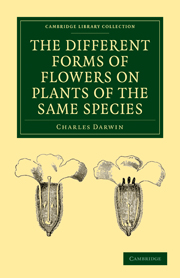Book contents
- Frontmatter
- Contents
- INTRODUCTION
- CHAPTER I HETEROSTYLED DIMORPHIC PLANTS: PRIMTULACEÆ
- CHAPTER II HYBRID PRIMULAS
- CHAPTER III HETEROSTYLED DIMORPHIC PLANTS–continued.
- CHAPTER IV HETEROSTYLED TRIMORPHIC PLANTS
- CHAPTER V ILLEGITIMATE OFFSPRING OF HETEROSTYLED PLANTS
- CHAPTER VI CONCLUDING REMARKS ON HETEROSTYLED PLANTS
- CHAPTER VII POLYGAMOUS, DIŒCTOUS, AND GYNO-DIŒCIOUS PLANTS
- CHAPTER VIII CLEISTOGAMIO FLOWERS
- INDEX
CHAPTER IV - HETEROSTYLED TRIMORPHIC PLANTS
Published online by Cambridge University Press: 05 July 2011
- Frontmatter
- Contents
- INTRODUCTION
- CHAPTER I HETEROSTYLED DIMORPHIC PLANTS: PRIMTULACEÆ
- CHAPTER II HYBRID PRIMULAS
- CHAPTER III HETEROSTYLED DIMORPHIC PLANTS–continued.
- CHAPTER IV HETEROSTYLED TRIMORPHIC PLANTS
- CHAPTER V ILLEGITIMATE OFFSPRING OF HETEROSTYLED PLANTS
- CHAPTER VI CONCLUDING REMARKS ON HETEROSTYLED PLANTS
- CHAPTER VII POLYGAMOUS, DIŒCTOUS, AND GYNO-DIŒCIOUS PLANTS
- CHAPTER VIII CLEISTOGAMIO FLOWERS
- INDEX
Summary
In the previous chapters various heterostyled dimorphic plants have been described, and now we come to heterostyled trimorphic plants, or those which present three forms. These have been observed in three families, and consist of species of Lythrum and of the allied genus Nesæa, of Oxalis and Pontederia. In their manner of fertilisation these plants offer a more remarkable case than can be found in any other plant or animal.
Lythrum salicaria.–The pistil in each form differs from that in either of the other forms, and in each there are two sets of stamens different in appearance and function. But one set of stamens in each form corresponds with a set in one of the other two forms. Altogether this one species includes three females or female organs and three sets of male organs, all as distinct from one another as if they belonged to different species; and if smaller functional differences are considered, there are five distinct sets of males. Two of the three hermaphrodites must coexist, and pollen must be carried by insects reciprocally from one to the other, in order that either of the two should be fully fertile; but unless all three forms coexist, two sets of stamens will be wasted, and the organisation of the species, as a whole, will be incomplete.
- Type
- Chapter
- Information
- The Different Forms of Flowers on Plants of the Same Species , pp. 137 - 187Publisher: Cambridge University PressPrint publication year: 2010First published in: 1877



